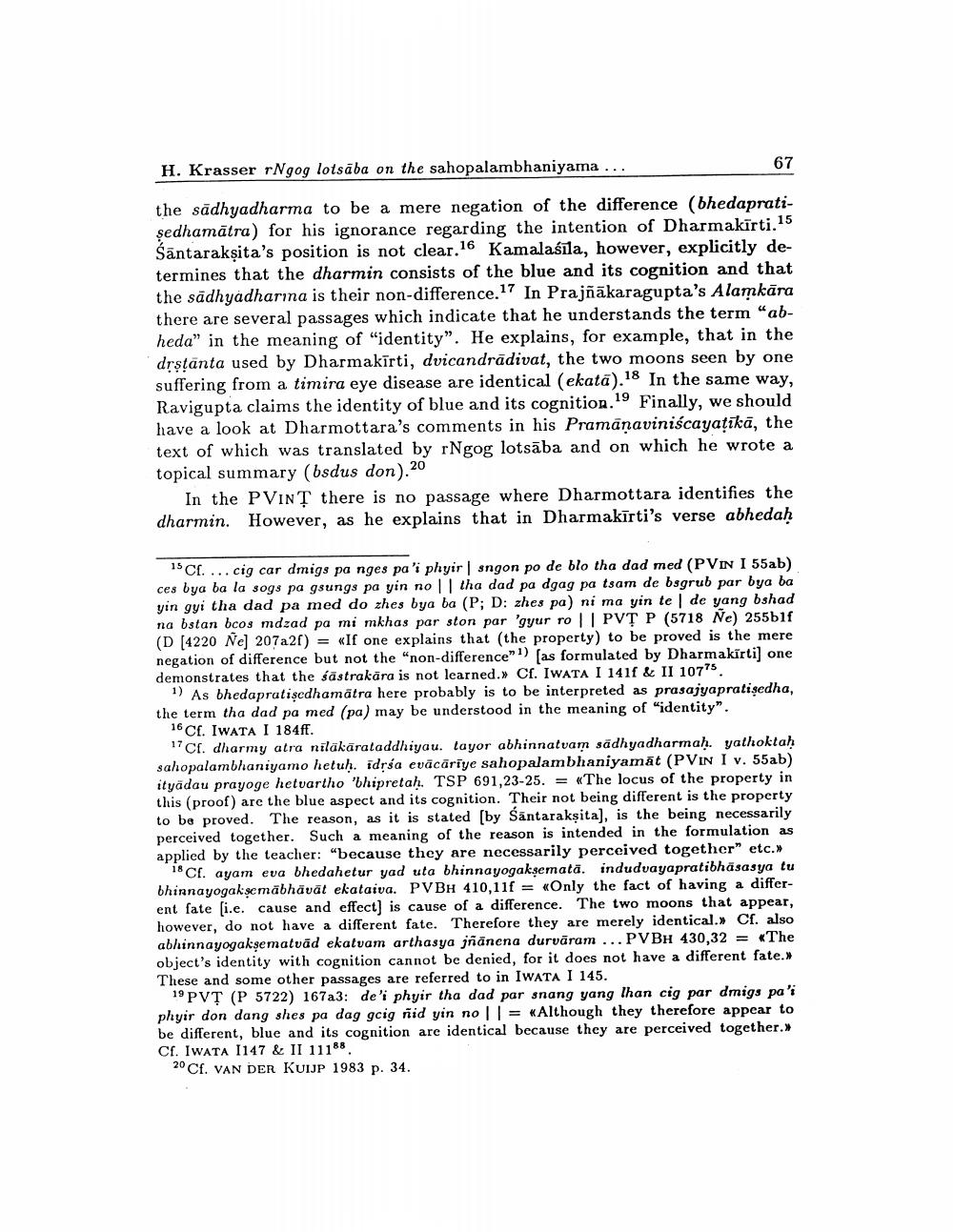Book Title: Rngog Lotsaba On Sahopalambhaniyama Proof In Dharmakirtis Pramanaviniscaya Author(s): Helmut Krasser Publisher: Helmut Krasser View full book textPage 5
________________ H. Krasser rNgog lotsāba on the sahopalambhaniyama ... 67 the sādhyadharma to be a mere negation of the difference (bhedapratişedhamātra) for his ignorance regarding the intention of Dharmakīrti. 15 Santarakṣita's position is not clear.16 Kamalaśīla, however, explicitly determines that the dharmin consists of the blue and its cognition and that the sadhyadharına is their non-difference.17 In Prajñākaragupta's Alamkāra there are several passages which indicate that he understands the term "abheda" in the meaning of "identity”. He explains, for example, that in the drstanta used by Dharmakīrti, dvicandradivat, the two moons seen by one suffering from a timira eye disease are identical (ekata).18 In the same way, Ravigupta claims the identity of blue and its cognition.19 Finally, we should have a look at Dharmottara's comments in his Pramanaviniscayaţikā, the text of which was translated by rNgog lotsāba and on which he wrote a topical summary (bsdus don).20 In the PVINŢ there is no passage where Dharmottara identifies the dharmin. However, as he explains that in Dharmakīrti's verse abhedah 15 Cf. ...cig car dmigs pa nges pa'i phyir sngon po de blo tha dad med (PVIN I 55ab) ces bya ba la sogs pa gsungs pa yin no || tha dad pa dgag pa tsam de bsgrub par bya ba yin gyi tha dad pa med do zhes bya ba (P; D: zhes pa) ni ma yin te de yang bshad na bstan bcos mdzad pa mi mkhas par ston par 'gyur ro|| PVȚ P (5718 Ne) 255b1f (D (4220 Nej 207a2f) = «If one explains that the property) to be proved is the mere negation of difference but not the "non-difference" 1) (as formulated by Dharmakirti) one demonstrates that the śāstrakāra is not learned. Cf. IWATA I 141f & II 10775. 1) As bhedapratiscdhamätra here probably is to be interpreted as prasajyapratişedha, the term tha dad pa med (pa) may be understood in the meaning of "identity". 16 Cf. IWATA I 184ff. 17 Cf. dharmy atra nīlākārataddhiyau. tayor abhinnatuam sadhyadharmaḥ yathoktah sahopalambhaniyamo hetuh. idrsa eväcäriye sahopalambhaniyamāt (PVIN I v. 55ab) ityadau prayoge hetvartho 'bhipretah. TSP 691,23-25. = «The locus of the property in this (proof) are the blue aspect and its cognition. Their not being different is the property to be proved. The reason, as it is stated (by Santarakṣita), is the being necessarily perceived together. Such a meaning of the reason is intended in the formulation as applied by the teacher: "because they are necessarily perceived together" etc.>> 18 Cl. ayam eva bhedahetur yad uta bhinnayogaksemata. indudvayapratibhāsasya tu bhinnayogakscmābhāvāt ekataiva. PVBH 410,11f = «Only the fact of having a different fate i.e. cause and effect) is cause of a difference. The two moons that appear, however, do not have a different fate. Therefore they are merely identical. Cf. also abhinnayogakşematväd ekatvam arthasya jñānena durvāram ... PVBH 430,32 = «The object's identity with cognition cannot be denied, for it does not have a different fate. These and some other passages are referred to in IWATA I 145. 19 PVT (P 5722) 167a3: de'i phyir tha dad par snang yang lhan cig par dmigs pa'i phyir don dang shes pa dag gcig nid yin no || = *Although they therefore appear to be different, blue and its cognition are identical because they are perceived together.>> Cf. IWATA I147 & II 11188 20 Cf. VAN DER KUIJP 1983 p. 34.Page Navigation
1 ... 3 4 5 6 7 8 9 10 11 12 13 14 15 16 17 18 19 20 21 22 23 24 25 26
